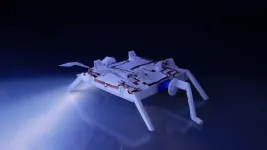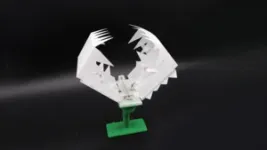(Press-News.org) Roboticists have been using a technique similar to the ancient art of paper folding to develop autonomous machines out of thin, flexible sheets. These lightweight robots are simpler and cheaper to make and more compact for easier storage and transport.
However, the rigid computer chips traditionally needed to enable advanced robot capabilities — sensing, analyzing and responding to the environment — add extra weight to the thin sheet materials and makes them harder to fold. The semiconductor-based components therefore have to be added after a robot has taken its final shape.
Now, a multidisciplinary team led by researchers at the UCLA Samueli School of Engineering has created a new fabrication technique for fully foldable robots that can perform a variety of complex tasks without relying on semiconductors. A study detailing the research findings was published in Nature Communications.
By embedding flexible and electrically conductive materials into a pre-cut, thin polyester film sheet, the researchers created a system of information-processing units, or transistors, which can be integrated with sensors and actuators. They then programmed the sheet with simple computer analogical functions that emulate those of semiconductors. Once cut, folded and assembled, the sheet transformed into an autonomous robot that can sense, analyze and act in response to their environments with precision. The researchers named their robots “OrigaMechs,” short for Origami MechanoBots.
“This work leads to a new class of origami robots with expanded capabilities and levels of autonomy while maintaining the favorable attributes associated with origami folding-based fabrication,” said study lead author Wenzhong Yan, a UCLA mechanical engineering doctoral student.
OrigaMechs derived their computing capabilities from a combination of mechanical origami multiplexed switches created by the folds and programmed Boolean logic commands, such as “AND,” “OR” and “NOT.” The switches enabled a mechanism that selectively output electrical signals based on the variable pressure and heat input into the system.
Using the new approach, the team built three robots to demonstrate the system’s potential:
an insect-like walking robot that reverses direction when either of its antennae senses an obstacle
a Venus flytrap-like robot that envelops a “prey” when both of its jaw sensors detect an object
a reprogrammable two-wheeled robot that can move along pre-designed paths of different geometric patterns
While the robots were tethered to a power source for the demonstration, the researchers said the long-term goal would be to outfit the autonomous origami robots with an embedded energy storage system powered by thin-film lithium batteries.
The chip-free design may lead to robots capable of working in extreme environments — strong radiative or magnetic fields, and places with intense radio frequency signals or high electrostatic discharges — where traditional semiconductor-based electronics might fail to function.
“These types of dangerous or unpredictable scenarios, such as during a natural or manmade disaster, could be where origami robots proved to be especially useful,” said study principal investigator Ankur Mehta, an assistant professor of electrical and computer engineering and director of UCLA’s Laboratory for Embedded Machines and Ubiquitous Robots.
“The robots could be designed for specialty functions and manufactured on demand very quickly,” Mehta added. “Also, while it’s a very long way away, there could be environments on other planets where explorer robots that are impervious to those scenarios would be very desirable.”
Pre-assembled robots built by this flexible cut-and-fold technique could be transported in flat packaging for massive space savings. This is important in scenarios such as space missions, where every cubic centimeter counts. The low-cost, lightweight and simple-to-fabricate robots could also lead to innovative educational tools or new types of toys and games.
Other authors on the study are UCLA undergraduate student Mauricio Deguchi and graduate student Zhaoliang Zheng, as well as roboticists Shuguang Li and Daniela Rus from the Massachusetts Institute of Technology.
The research was supported by the National Science Foundation. Yan and Mehta are applying for a patent through the UCLA Technology Development Group.
END
Origami-inspired robots can sense, analyze and act in challenging environments
UCLA-led team built chip-free, autonomous OrigaMechs with conductive materials
2023-04-03
ELSE PRESS RELEASES FROM THIS DATE:
Analysis of dinosaur eggshells: bird-like Troodon laid 4 to 6 eggs in a communal nest
2023-04-03
FRANKFURT. In millions of years and with a long sequence of small changes, evolution has shaped a particular group of dinosaurs, the theropods, into the birds we watch fly around the planet today. In fact, birds are the only descendants of dinosaurs which survived the catastrophic extinction 66 million years ago that ended the Cretaceous period.
Troodon was such a theropod. The carnivorous dinosaur was about two meters long and populated the vast semi-arid landscapes of North America about 75 million years ago. Like some of its dinosaur relatives, Troodon presented some bird-like ...
Remember me? Gender, race may make you forgettable
2023-04-03
ITHACA, N.Y. - At an academic conference some years ago, Michèle Belot remembers talking with a participant who was convinced she had authored a research paper that wasn’t hers. He’d confused her with another female scholar, an experience she said is familiar to many colleagues.
Such incidents – plus awareness of her own imperfect memory – inspired Belot, a professor in the Department of Economics at Cornell University, to investigate systemic biases in the way we remember people, since this could influence social networks important to career advancement.
In new research focused on academia, Belot ...
Non-invasive brain stimulation can regulate autonomic responses and improve oxygen saturation in hospitalized patients with Covid-19
2023-04-03
Among the health problems developed or aggravated by Covid-19, those that affect neurological and respiratory functions draw special attention from specialists. Considering several studies that show the adverse effects of Covid-19 on human autonomic functions, which are those regulated by the Autonomic Nervous System (ANS), a recent Brazilian study has demonstrated that the use of non-invasive brain stimulation was capable of regulating the ANS and increasing the oxygen saturation in patients with Covid-19 admitted to a semi-intensive ...
Pharmacy PhD student from Iraq wins award at major international conference
2023-04-03
A PhD student from the University of Huddersfield’s Department of Pharmacy competed against entries from around the world to win the prize for ‘Best Oral Presentation’ at a major international conference for the pharmaceutical sciences.
Haja Muhamad is in the final year of her PhD and is being supervised by the University’s Dr Kofi Asare-Addo. Her prize-winning talk, presented at the 13th Academy of Pharmaceutical Sciences International Conference during the ‘New Scientist Focus Group (NSFG)’ session, was titled ‘An ...
Public reporting has not improved German hospital quality
2023-04-03
Hospital quality has been measured and made publicly available for more than two decades in the US. In Germany, similar efforts were launched in 2004, when all acute care hospitals began being required to report structural, process, and outcome indicators as part of a national quality monitoring program. Hospitals are now mandated to submit quality reports annually. The German hospital market presents a unique opportunity to examine the relationship between public reporting and quality improvement in the absence of performance-linked payment incentives in a high-income country. In an analysis about the successes of quality measurement to date, Esra Eren Bayindir and Jonas Schreyögg, ...
Medicaid reimbursement for mental health varies widely across states
2023-04-03
Medicaid reimbursement for the same mental health treatment varies dramatically among U.S. states, according to a new study by researchers at Oregon Health & Science University.
The study published today in the April edition of the journal Health Affairs.
Medicaid is the largest single payer for mental health services in the country, yet previous research shows that many health care providers won’t accept patients covered by Medicaid — despite the fact that it serves a population disproportionately affected by mental illness.
In this study, researchers documented commonly billed services to psychiatrists nationwide, and then compared ...
Virginia Tech researchers fight fire blight’s plight on apple production
2023-04-03
As the old English proverb goes, “An apple a day keeps the doctor away.”
It’s long been known that apples offer multiple health benefits. Rich in fiber and antioxidants, they are linked to a lower risk of many chronic conditions, including diabetes, heart disease, and cancer.
And while apples help protect human health, what is being done to protect the health of this delicious and nutritious fruit?
Researchers at the Alson H. Smith Jr. Agricultural and Extension Research Center, a Virginia Tech facility in Winchester well-known for its contributions to the commercial ...
Huddersfield Business School awarded coveted AACSB Accreditation
2023-04-03
Huddersfield Business School has been awarded a coveted accreditation which less than six percent of institutions offering business degree programmes manage to achieve and is a result of ‘its dedication not only to the students, alumni network, and greater business community, but to the higher education industry as a whole’.
AACSB accreditation from AACSB International ensures continuous improvement and provides focus for schools to deliver on their mission, innovate, and drive impact. The accreditation was led by Huddersfield Business School’s former Dean Professor Jill Johnes who retired at the end of January ...
Galaxy clusters yield new evidence for standard model of cosmology
2023-04-03
Cosmologists have found new evidence for the standard model of cosmology – this time, using data on the structure of galaxy clusters.
In a recent study, a team led by physicists at the Department of Energy's SLAC National Accelerator Laboratory and Stanford University made detailed measurements of the X-ray emission from galaxy clusters, which revealed the distribution of matter within them. In turn, the data helped the scientists test the prevailing theory of the structure and evolution of the universe, known as Lambda-CDM.
Getting there wasn’t an easy task, however.
Here's ...
New UH project combats food insecurity through AI
2023-04-03
One in eight Texans experiences food insecurity, according to the non-profit agency Feeding America. That means 1.4 million Texas households are food insecure, with limited or inconsistent access to nutritious food for an active, healthy life. The USDA's most recent survey on the issue reported that Texas is among the top nine U.S. states with a higher prevalence of food insecurity than the national average.
To address this issue, a University of Houston-led team is developing an artificial intelligence-based platform that can support the food charity ecosystem through data-driven technologies.
"The commitment of our team is to help our fellow ...
LAST 30 PRESS RELEASES:
New modeling approach sheds light on rare gut disease
Study documents potentially hazardous flame retardants in firefighter gear
Can certain bacteria regulate aging of the immune system and its related alterations?
AI model helps diagnose often undetected heart disease from simple EKG
There are fewer online trolls than people think
Cell membrane fluctuations produce electricity
Jeonbuk National University study shows positive parenting can protect adolescents against self-harm
Surface-engineered ZnO nanocrystals to tackle perfluoroalkyl substance contamination
This new understanding of T cell receptors may improve cancer immunotherapies
A new fossil face sheds light on early migrations of ancient human ancestor
A new immunotherapy approach could work for many types of cancer
A new way to diagnose deadly lung infections and save lives
40 percent of MRI signals do not correspond to actual brain activity
How brain-inspired algorithms could drive down AI energy costs
Gum disease may be linked to plaque buildup in arteries, higher risk of major CVD events
Contrails are a major driver of aviation’s climate impact
Structure of dopamine-releasing neurons relates to the type of circuits they form for smell-processing
Reducing social isolation protects the brain in later life
Keeping the heart healthy increases longevity even after cancer
Young adults commonly mix cannabis with nicotine and tobacco
Comprehensive review illuminates tau protein's dual nature in brain health, disease, and emerging psychiatric connections
Book prepares K-12 leaders for the next public health crisis
Storms in the Southern Ocean mitigates global warming
Seals on the move: Research reveals key data for offshore development and international ecology
Sports injuries sustained during your period might be more severe
World's first successful 2 Tbit/s free-space optical communication using small optical terminals mountable on satellites and HAPS
Can intimate relationships affect your heart? New study says ‘yes’
Scalable and healable gradient textiles for multi‑scenario radiative cooling via bicomponent blow spinning
Research shows informed traders never let a good climate crisis go to waste
Intelligent XGBoost framework enhances asphalt pavement skid resistance assessment
[Press-News.org] Origami-inspired robots can sense, analyze and act in challenging environmentsUCLA-led team built chip-free, autonomous OrigaMechs with conductive materials






